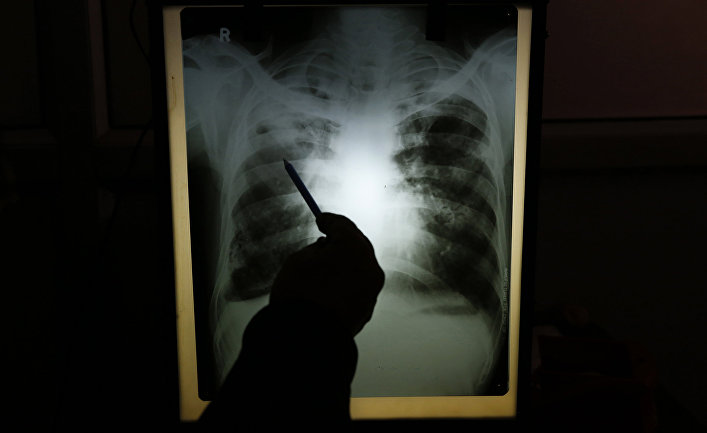
We live in a world where the processes of continuous introduction of innovative ideas of normal and not attract attention. We expect an endless stream of new and better things will accelerate the growth of development and prosperity. But it was not always so. From the beginning of history until about the nineteenth century all were farmers on the verge of survival, all were poor, and the growth of income of the average citizen was equal to zero. Innovative economy — is rather an exception in the history of mankind. And the path to this exception paved the struggle with infectious diseases.
Innovations occur when a large number of people gather in close proximity to each other and tell each other about their ideas and insights. Innovation requires personal contacts and social ties. The dependence of the innovation density of social interaction can be accurately described in simple equations — those that show how the spread of infectious diseases.
As a and innovation, some of the disease determine the development of whole societies and cultures, setting opportunities and constraints. The disease is not just suffering, it can destroy innovation, civilization and even an entire species.
It should not surprise us that the control of infectious diseases played an important role in the development of our constantly changing world. Until such control is necessary to concentrate minds entailed the spread of diseases that have hit on innovative development.
The population of the largest cities in the civilized world in 1800 was only a few hundred thousand people. Residents were dying faster than the new born citizens, and even these modest rates of the population survived only due to the constant influx of migrants from rural areas.
Among all the diseases that ravaged the growing city, the worst was the TB. “Havoc” is an understatement: every tenth died. The proportion of TB accounted for a quarter of all deaths in the cities of Europe and North America in the early nineteenth century. Killed 80% of infected individuals. Like today’s AIDS, the devastating impact of tuberculosis was due to the fact that the victims were generally young men — the most dynamic, productive and innovative members of society. Because of tuberculosis in many Georgian and Victorian novels, the theme of orphans and orphanages.
The Golden age of public health from approximately 1860 to 1960 largely overlaps with the Golden age of innovation, and this is no coincidence. Clean water, food and vaccines made the city with a large population density suitable for life, which gave impetus to the development of innovation and creativity to an unprecedented level. A sharp decline in child mortality has saved women from having to much to bear and nurse the children during the endless medical crises. The answer was the desire of women to education and to participate in public life. Before in the history of mankind, this was not.
The proportion of deaths from tuberculosis as from other infectious diseases is strongly reduced. In England and Wales the number of victims of infections between 1860 and 1950 had fallen by almost 90% in other industrialized countries, statistics were similar. And this reduction preceded the time when antibiotics became available to the public. It can surely be explained by measures in the field of public health, first and foremost, the availability of clean water and food, as well as the development of vaccines. We know how to prevent the spread of infectious diseases, and this thought is comforting in a world where antibiotics are beginning to lose their invulnerability.
But this is a good story there is one caveat: we don’t know why TB has receded. This can be partly linked with pasteurization of milk, after which spread bovine tuberculosis. Tuberculosis is not transmitted through food, so sanitation of slaughterhouses and the development of the cooling systems had no impact. Unlike yellow fever or malaria, tuberculosis is not spread by insects, so it could not stop the inning. Water purification to prevent diarrheal diseases claimed the lives of many children, however, does not prevent the spread of tuberculosis transmitted from person to person. Vaccines stopped these killer diseases as diphtheria and smallpox, but vaccination against TB is not too effective.
Historians of medicine have also made other assumptions. After the German physician Robert Koch (Robert Koch) in 1882 established the infectious nature of tuberculosis, we began to create the insulators and resorts to break the chain of disease transmission. But such attempts were inconsistent and isolated, and many scientists doubt they played more than a minimal role in the fight against tuberculosis. Because the mortality rate from this disease for a long time was very high, was nominated and the assumption that the decrease in the incidence influenced by the mechanisms of natural selection and the formation of innate immunity. In favor of this hypothesis is some evidence.
British doctor and historian of medicine Thomas McKeown (Thomas McKeown) reacted to this explanation with skepticism. In the 1960s and 1970s he published a series of works in which the objected that tuberculosis in principle, and perhaps completely, is a social disease that has not responded to measures in the field of medicine and healthcare, and to improve the living conditions of the people. McKeon indicated that the decrease in TB incidence started earlier than other infectious diseases, and the rate of this reduction is closely intertwined with measures in favor of growth, social wellbeing, and not with the introduction of different methods of protection of public health and medical interventions. Despite training, McKeon became a kind of nihilist from medicine, asserting that curative measures are meaningless, and the funds allocated to research and development of the British national health service, the cost would be better spent on food and housing for the poor.
In the thesis Makkena have an intuitive appeal. In rich countries, tuberculosis has almost disappeared and is considered a disease of the poor. But subsequent studies based on more complex analysis of demographic and economic data have not confirmed claims Mackeon, and now his thesis is considered to be largely refuted. However, no other explanation has not received wide support.
In the late 1940s, it seemed that the advent of antibiotics for the treatment of tuberculosis makes all these arguments irrelevant and uninteresting to anyone but historians of medicine. For the first time, tuberculosis can be treated with streptomycin, isoniazid, rifampin. The chain of transmission could be broken without placing patients in isolation. No longer needed to meet the challenge of providing poor people around the world worthy of food and shelter. Antibiotics were cheap and effective. If they could give each patient, the TB threat to human health and civilization would have remained in the past, and probably forever.
Thus, the emergence of tuberculosis resistant to antibiotics became a special hazard that is not similar to the threat posed by so-called superbugs and much more serious. Most multiple-resistant bacteria have reduced virulence — the ability to spread and cause disease in a host organism.
They rarely strike otherwise healthy people. For most pathogens — methicillinresistant Staphylococcus aureus, Enterococcus carbapenemresistant, vancomycinresistant enterococci, beta-lactamase extended-spectrum — risk factor for serious infections and death are advanced age, hospitalization, immunosuppression and recent antibiotics. They attack old and sick, not young and healthy.
Multi-drug resistance is not the acquisition of such sign does not make the disease less contagious. The age of most of the patients are from 25 to 45 years, meaning they are in the Prime of life. The main risk factors — TB therapy in the past, and refugee status. Tuberculosis multidrug-resistant treatable, but it is difficult, costly, and often ineffective. In 2015 it tuberculosis sick half a million people, and only a quarter of them received adequate treatment and recover.
Most organisms as the distribution becomes less virulent, but it is possible that multi-drug resistance is even more contagious in areas with high population density. If this is true, then we’re in big trouble. We don’t have a reliable plan B in the event of an outbreak of virulent strains of drug-resistant. You can’t isolate millions of patients. Improved sanitation does not help, as the disease spreads from person to person through coughing, sneezing and even talking. Maybe natural selection has made us less susceptible to infection than our ancestors, but it is only a hope, not a plan.
At some point, the TB can undermine our progressive and innovative society.
The interaction between the “producers” whom we entrust the management of our economy, will contribute to the spread of the deadly, difficult to treat diseases. The worst hit will be young adults, the disease will sooner cut off their life and career, from which our social structures will undergo huge deformations. Our economic system, with its strong inter-linkages have been able to reduce poverty to the minimum historical level, but it starts to break down, creating a cycle of positive feedback and causing more disease and disruption.
Of course, maybe none of this would happen. But consider the worst-case scenario: new strains of tuberculosis in combination with climate-driven crop failures lead to mass migration. The result may be an unstoppable epidemic that will put an end to the modern economy. We are more vulnerable than you think: the white death could come back.
Drew Smith, a molecular biologist from the University of Colorado at boulder. Was a scientist and Director of research projects in several biotech and medical companies, one of which was developed the methods of diagnostics of infectious diseases.







